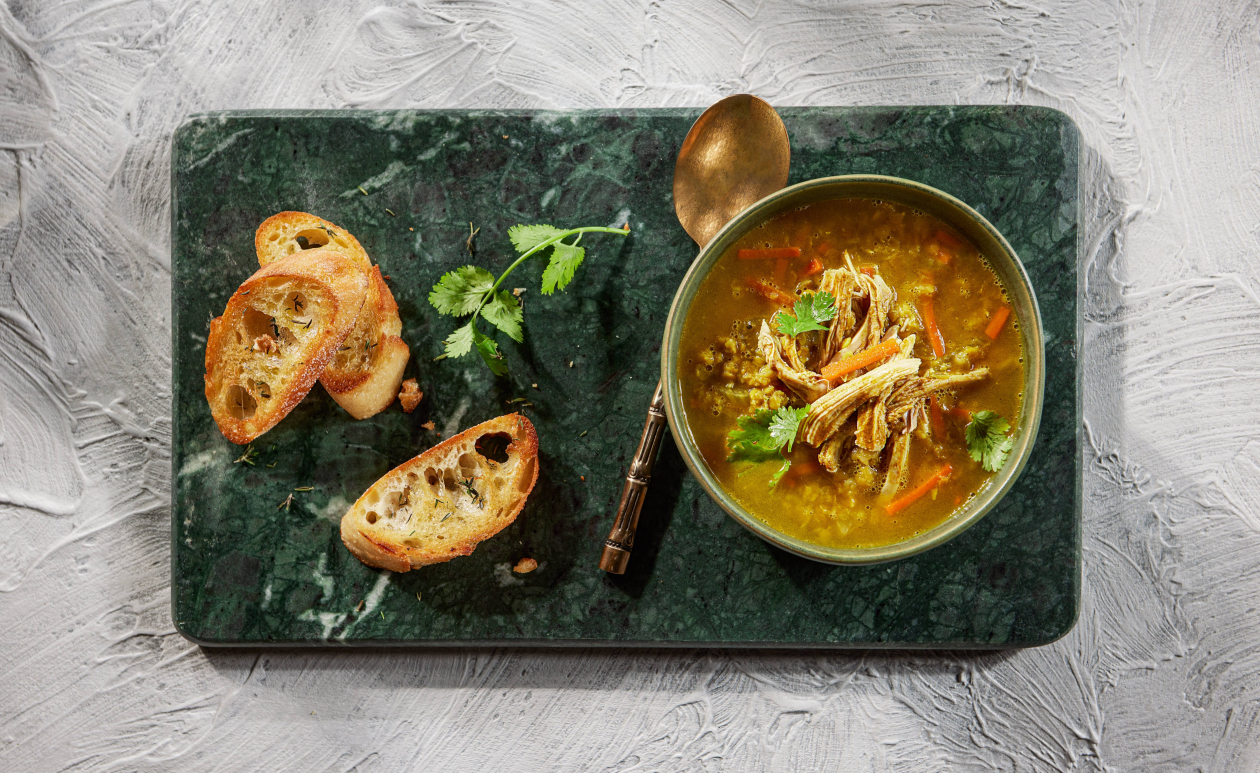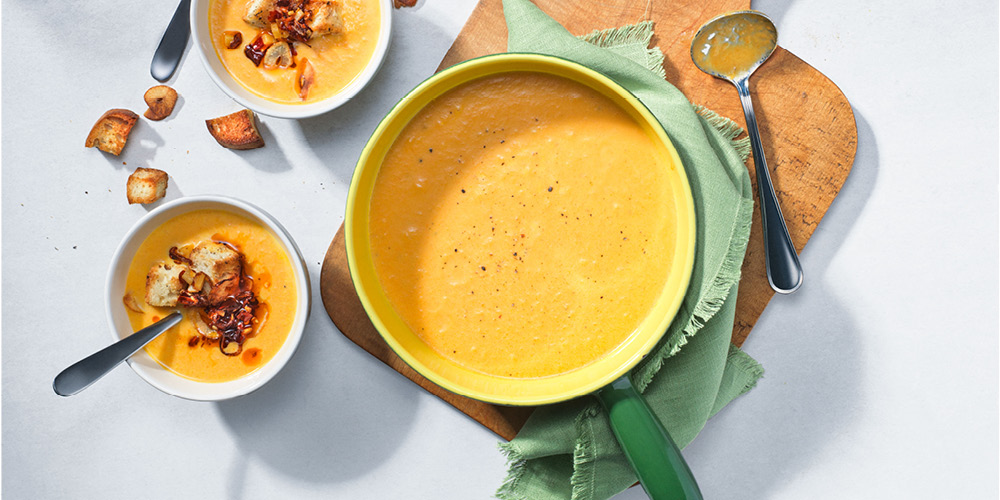
As fall fades into winter, there’s no better feeling than the warm embrace of a bowl of soup. This season we’re celebrating these unsung heroes of the culinary world. Versatile, nourishing, and customizable, soups are a dish that offer endless possibilities in the kitchen. And while the ingredients and flavors change, most soups follow a similar formula. Once you understand the basics, getting creative with tastes, textures, and ingredients is simple and fun. The Wesson kitchen has laid out the ultimate formula to craft the perfect bowl of soup.

Step 1: Perfecting Your Base
A good base lays the foundation for a good bowl of soup. Broadly speaking, there are two types of soup bases: broth bases for thinner soups and cream or puréed bases for thicker soups.
As the name suggests, broth-based soups are made with broth or stock. Chicken, beef, and vegetable broth can be found at most grocery stores. However, we recommend making your own at home for the extra flavor and freshness. For this, we love AllRecipes’ chicken broth recipe. Tip: homemade broths can be stored in the freezer for up to 3 months and are an excellent ingredient to batch prep.
Cream soups also contain broth but are then thickened with thickening agents such as heavy cream, yogurt, or corn flour. The thickening agent is usually added near the end of the recipe.
Puréeing or blending a soup is another simple way to achieve a creamier, thicker texture. Simply boil your ingredients in water or broth, add seasoning, and then blend in a blender until the desired texture is achieved.
Step 2: Enhance Flavor with Aromatics
Aromatics, or vegetables and herbs that add flavor and aroma to a dish, are a must-have for any good soup. The classic go-to for American and French soups is the mirepoix; a 2:1:1 ratio of onions, celery, and carrots, sautéed to perfection with Wesson Canola Oil. Sautéing your aromatics is a crucial step as it helps release their flavors and Wesson oil is a perfect candidate for this job. Wesson’s light taste will enhance but not overpower the aromatics’ natural flavor while its high smoke point prevents burning while sautéing.
Wesson’s Autumn Spiced Pumpkin Soup uses red peppers and tomatoes as a flavor base, both of which are also common aromatics that add a sweet and tangy twist to the dish.

Step 3: Incorporate Your Protein
Adding in protein is an optional step that can help make your soup more filling. We love using chicken, an incredibly versatile ingredient that shines in dishes ranging from the classic chicken noodle to this South Indian inspired Mulligatawny Soup. Depending on your dietary preferences, beef, pork, and tofu are other options that can be sautéed with your aromatics and added into the pot.
Tip: If you’re using pre-cooked proteins such as canned beans or shredded rotisserie chicken, hold off on adding these into your pot until the final step to prevent overcooking.

Step 4: Add In Your Root Vegetables
When it comes to adding vegetables into your soup, it’s important to consider cooking times. Heartier, root and cruciferous vegetables have longer cooking times and should be added earlier in the process. Vegetables with higher water contents, such as leafy greens, have shorter cooking times and can be added later.
Examples of vegetables that should be added early on include sweet potatoes, broccoli, beets, and cauliflower. Try sautéing these veggies for a couple minutes before adding in the broth, as this shortens their cooking time and boosts flavor.
Another alternative is to roast your heartier veggies in the oven before adding them to your pot. Roasting works especially well with root vegetables, like the butternut squash in our Thai Butternut Squash Soup or the carrots in this Roasted Carrot and Ginger Spiced Soup, because the oven’s high heat brings out their rich, earthly flavors.

Step 5: Season with Spices, Herbs & Sauces
Seasonings are another necessary step for any good soup as they add a flavorful punch while providing direction and depth to the dish.
Dry seasonings like spices and dried herbs can be added to the sautéed vegetables before the broth is poured in. We love using spice mixes, such as Cajun or Italian seasoning, as well as herbs like oregano, basil, and parsley. Pastes such as miso and curry can also be added at this step.
Sauces and other liquid flavor enhancers work better when added after the broth. These include ingredients like fish sauce, soy sauce, red or white wine, and coconut milk.
Step 6: Stir In Your Leafy Vegetables
Most recipes recommend bringing your soup to a boil before reducing the heat and letting it simmer. While your soup is simmering, stir in softer vegetables such as spinach, kale, and chard. Compared to the heartier, root vegetables from Step 4, leafy greens have a shorter cooking time and can be added much later in the process. This is also a great time to add in any pre-cooked ingredients, including rice, quinoa, and canned beans. Dry pasta and noodles should be added in a little earlier so they can be cooked to al dente.

Step 7: The Finishing Touches
While cooking times vary, a good rule of thumb is to simmer your soup until everything is tender. This is also a good time to taste the soup and add any additional seasonings. As a last step, give your soup extra flavor and visual appeal through toppings such as fresh basil, cilantro, yogurt or sour cream, and chili oil.
And there you go! You’ve got yourself a pot of warm and delicious goodness to take on soup season and the cooler weather with. Enjoy it on its own or pair it with Wesson Basics White Bread for an extra filling meal.
Visit our Instagram page for more recipe inspiration!

